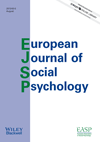Counter-prejudicial training reduces activation of biased associations and enhances response monitoring
Abstract
Although implicitly measured bias was once assumed to be highly stable, subsequent research has shown that it is, in fact, malleable. One technique for altering implicit bias is through counter-prejudicial training. At least two broad mechanisms may drive this effect. First, training people to respond in counter-prejudicial ways may diminish the extent to which biased associations are activated in memory. Second, training may strengthen processes that reduce the influence of biased associations on responses. Participants received either counter-prejudicial, pro-prejudicial, or no training and then completed an implicit measure of bias. Application of the quadruple process model revealed support for both mechanisms: Counter-prejudicial training produced less activation of biased associations as well as enhanced detection of appropriate responses compared with pro-prejudicial or no training. Implications for the development of bias-reduction training are discussed. Copyright © 2013 John Wiley & Sons, Ltd.




